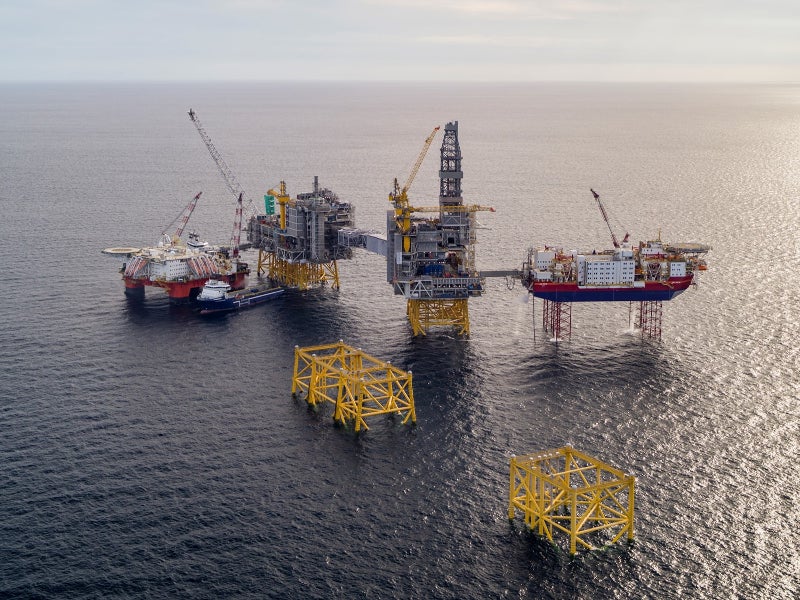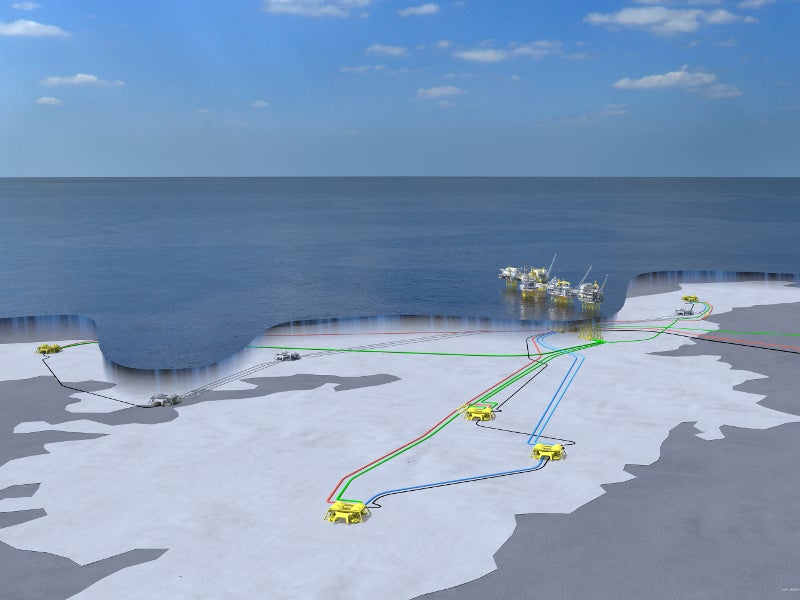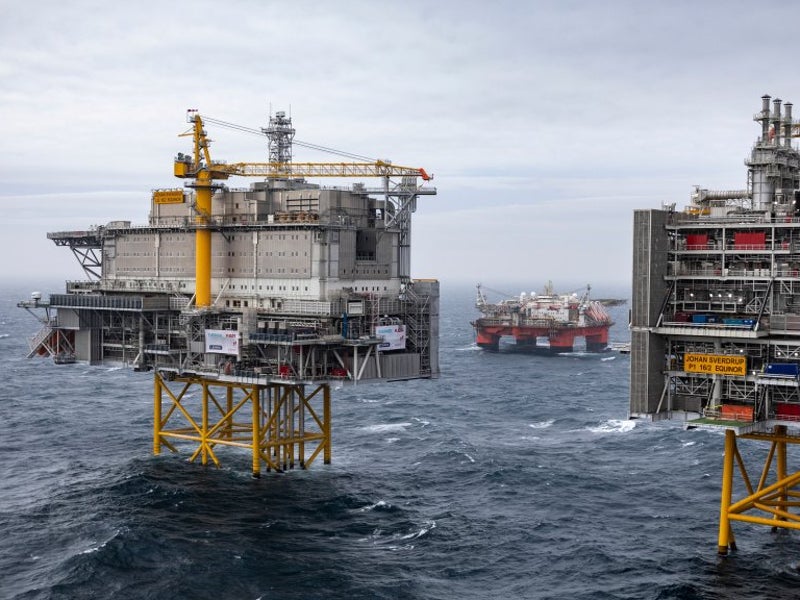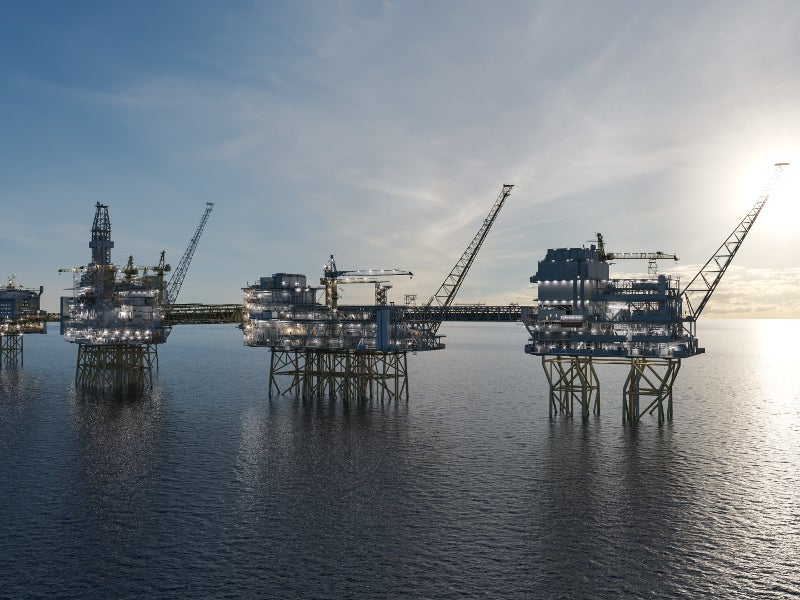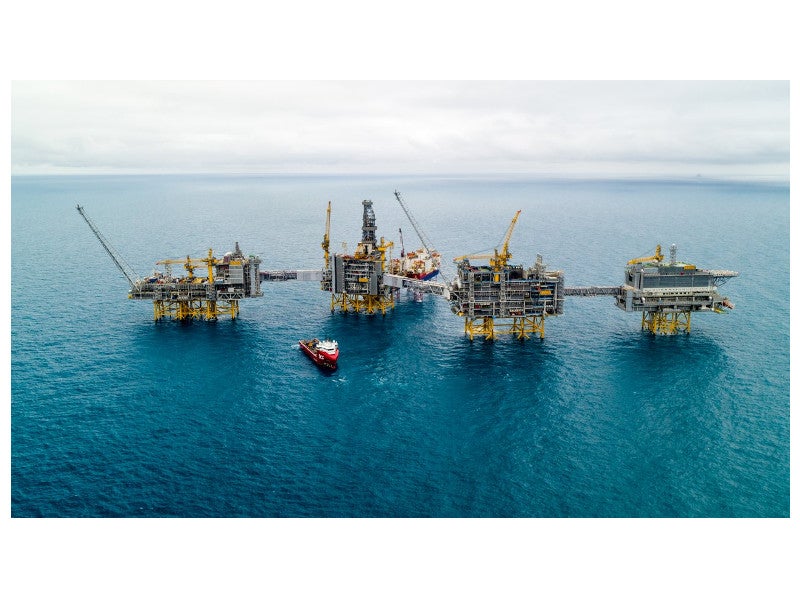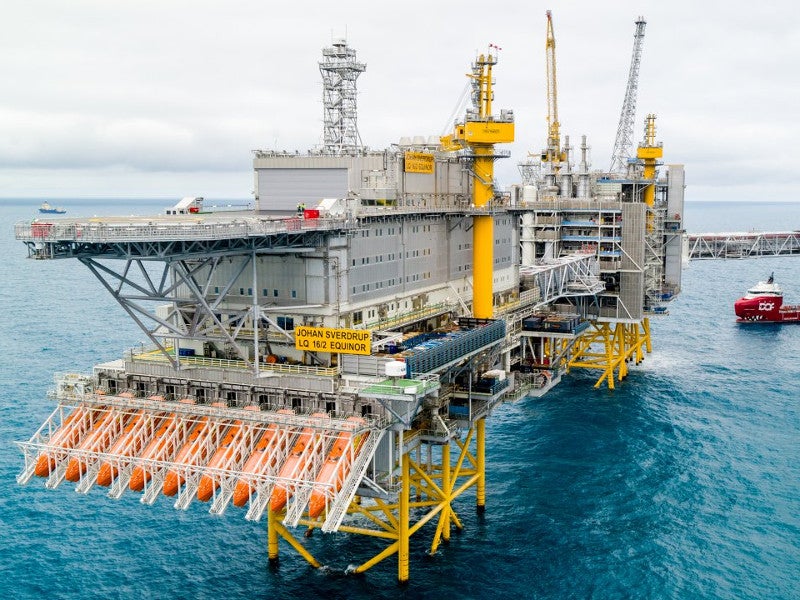Johan Sverdrup offshore development is located approximately 150km away from the coast of Stavanger, Norway, in the Norwegian North Sea. It is considered to be one of the biggest oil fields on the Norwegian continental shelf and comprises the Avaldsnes and Aldous discoveries.
The field is jointly owned by Equinor (42.6%, operator), Lundin Norway (20%), Petoro (17.36%), Aker BP (11.57%) and Total (8.44%). It is being developed in two phases, with the first phase estimated to cost £7.3bn ($9.1bn).
The PDO for phase one of the Johan Sverdrup offshore development was approved in August 2015. Construction on phase one of the project commenced in March 2016 and production started in October 2019.
The second phase is being developed with an estimated investment of £3.6bn ($4.5bn). The plan for operation and development (PDO) of phase two was submitted to the Norwegian Ministry of Petroleum and Energy in August 2018 and the same was approved in May 2019. Construction on the second phase began in May 2019 and commissioning is expected in the fourth quarter of 2022.
Johan Sverdrup is expected to account for more than half of Norway’s oil production by 2040. The production life of the project is expected to be 50 years.
Details of the Avaldsnes and Aldous discoveries offshore Stavanger
Avaldsnes field was discovered in 2010 by the 16/2-6 well and includes Aldous Major South and Aldous Major North.
The Aldous Major South was discovered in August 2011 by the 16/2-8 well, which was drilled to a depth of 2,083m and encountered an oil column of 65m.
The Aldous Major North is a minor field, discovered by the 16/2-9S well, which was drilled to a depth of 2,047m in September 2011. Lundin drilled the well to confirm an extension of the Aldous Major South field in the north.
Geology and reserves of the Johan Sverdrup field
The field reservoir is made of lower Cretaceous/Jurassic age high porosity and permeability sandstones. It is a four-way dip closure located at a depth of 1,900m with normal pressure and temperature.
Johan Sverdrup is estimated to hold between 0.8 and 1.8 billion barrels of gross recoverable oil in PL501 and between 0.9 and 1.5 billion barrels of gross recoverable oil in PL265. Total reserves of the field are estimated between 1.7 and 3.3 billion barrels of gross recoverable oil.
The oil present in the field is highly mobile with low viscosity. It has an API of 28° and a low gas/oil ratio.
Exploration and drilling at Avaldsnes and Aldous discoveries
Lundin drilled three appraisal wells, 16/3-4, 16/2-7 and 16/5-2S, at the Avaldsnes discovery. Sidetracks for the first and second appraisal wells were also drilled.
The first appraisal well, 16/3-4, confirmed the extension of the Avaldsnes discovery to the south-east. It was drilled to a depth of 2,020m and encountered a 13.5m thick oil column. Sidetrack to the well, 16/3-4A, was drilled to a depth of 1,934m to examine the reservoir’s quality.
The 16/2-7 appraisal well drilled to a depth of 2,500m and established the extension of the Avaldsnes field. The sidetrack well, 16/2-7A, encountered a reservoir column of 25m. It was drilled 400m north-east of the 16/2-7 appraisal well.
Another appraisal well, 16/2-10, was drilled on the Aldous Major South discovery, which confirmed its northern extension. It was drilled by Transocean Leader semi-submersible rig and encountered a 50m to 55m thick oil column in Jurassic age sandstones.
Lundin completed the drilling of another appraisal well, 16/2-11, in March 2012. Drilled by the Bredford Dolphin semi-submersible drilling rig, it encountered a 54m gross oil column.
The 16/5-3 appraisal well was drilled in PL502, which confirmed a 13.5m oil column in a high-quality Jurassic reservoir.
Johan Sverdrup field development details
The first phase involved the installation of four bridge connected platforms, including an accommodation and utility platform, a processing platform, a drilling platform and a riser platform. It also includes three subsea installations for water injection and 35 injection and production wells.
The first building block of the Johan Sverdrup development was completed and installed on the field in August 2015. Phase one has a production capacity of 440,000 barrels of oil per day (bpd).
The produced oil and gas from the field is delivered to the shore through oil and gas pipelines. The oil pipeline transports oil to the Mongstad Terminal in Norway while the gas pipeline delivers gas to the Kårstø Terminal.
Phase two of the project will include the development of a second processing platform and five subsea templates. The existing riser and field centre will be modified to receive the production from phase two.
The second phase will have a production capacity of 220,000bpd, bringing the total production of the Johan Sverdrup field to 660,000bpd.
Contractors involved
The feasibility and concept studies, as well as front end engineering design (FEED) for phase one of the project, was done by Aker Solutions. The company was also awarded the engineering services, procurement and management assistance (EPMA) contract for the phase.
Kvaerner received a $119m contract to supply jackets for the process platform and drilling platform for the field, while Samsung Heavy Industries received an approximately $836m contract to fabricate topsides for the processing and riser platforms in June 2015.
Aibel received a $956m contract to deliver engineering, procurement and construction (EPC) services for the deck of the drilling platform. The company was also contracted for building two onshore converter stations for the development of Johan Sverdrup field.
Aker Solutions and Kvaerner won a $373m contract to carry out modifications on the riser platform for the second phase of the project in April 2018.
Suppliers and contractors involved in the project include ABB, Autronica Fire and Security, Flux Group, Rapp Bomek, IKM Ocean Design, FMC Kongsberg, Baker Hughes and Odfjell Drilling.
Siemens, NKT, Technip FMC, Kaefer Energy, Kongsberg Maritime, Dragados Offshore and Subsea 7 are the other contractors involved in the development of the Johan offshore field.

